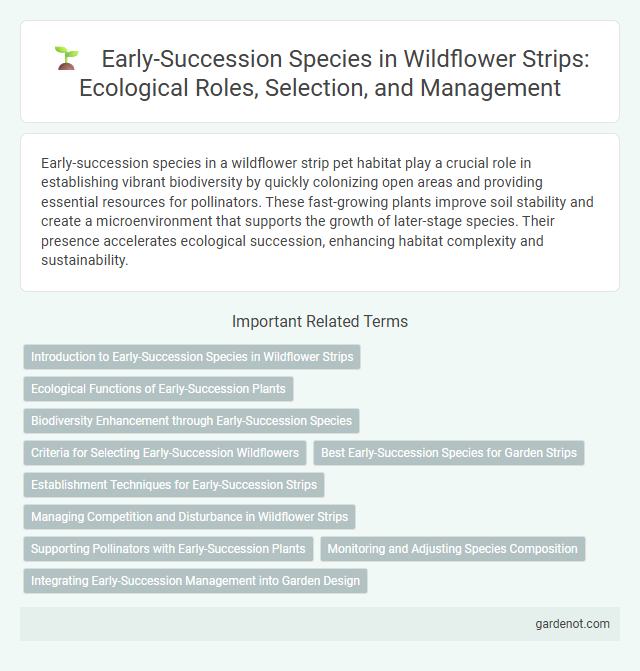Early-succession species in a wildflower strip pet habitat play a crucial role in establishing vibrant biodiversity by quickly colonizing open areas and providing essential resources for pollinators. These fast-growing plants improve soil stability and create a microenvironment that supports the growth of later-stage species. Their presence accelerates ecological succession, enhancing habitat complexity and sustainability.
Introduction to Early-Succession Species in Wildflower Strips
Early-succession species in wildflower strips are fast-growing plants that quickly establish after soil disturbance, promoting biodiversity and habitat restoration. These species, including native grasses and wildflowers like goldenrod and asters, support pollinators and beneficial insects during initial growth stages. Incorporating early-succession plants enhances ecological resilience and accelerates succession toward mature plant communities.
Ecological Functions of Early-Succession Plants
Early-succession species in wildflower strips play a crucial role in soil stabilization and nutrient cycling, promoting ecosystem recovery after disturbance. These plants provide essential habitat and food resources for pollinators and beneficial insects, enhancing biodiversity and pest control. Their rapid growth and adaptability facilitate the establishment of a stable plant community, supporting long-term ecological resilience.
Biodiversity Enhancement through Early-Succession Species
Early-succession species in wildflower strips play a crucial role in biodiversity enhancement by providing essential habitats and food sources for pollinators such as bees and butterflies. These pioneer plants rapidly colonize disturbed soils, increasing plant diversity and supporting a wide range of insects and bird species. Integrating early-succession species accelerates ecosystem recovery and promotes a resilient, balanced environment within agricultural landscapes.
Criteria for Selecting Early-Succession Wildflowers
Selecting early-succession wildflowers for a wildflower strip involves prioritizing fast-growing, shade-intolerant species that establish quickly to stabilize soil and outcompete invasive weeds. Key criteria include seed availability, germination rate, and adaptability to local soil and climate conditions, ensuring rapid establishment and ecological resilience. Species like Clarkia, California poppy, and lupine are exemplary early-succession wildflowers due to their ability to thrive in disturbed areas and support pollinators early in the season.
Best Early-Succession Species for Garden Strips
Early-succession species such as New England Aster, Black-eyed Susan, and Butterfly Weed are ideal for wildflower garden strips due to their rapid growth and vibrant blooms that attract pollinators. These species establish quickly after soil disturbance, improving biodiversity and supporting native insect populations. Incorporating these plants enhances ecosystem resilience by providing early-season forage for bees, butterflies, and beneficial insects in garden strips.
Establishment Techniques for Early-Succession Strips
Establishment techniques for early-succession wildflower strips emphasize soil preparation methods such as shallow tilling or herbicide application to reduce existing vegetation competition. Selecting native pioneer species with rapid germination rates enhances initial cover and soil stabilization, promoting ecosystem recovery. Regular monitoring and adaptive management, including targeted mowing or spot treatments, help maintain species diversity and prevent invasion by undesirable plants.
Managing Competition and Disturbance in Wildflower Strips
Early-succession species in wildflower strips require careful management of competition and disturbance to establish successfully. Regular mowing or controlled grazing disrupts dominant grasses and invasive plants, promoting light availability and nutrient access for these species. Disturbance intervals timed to their growth cycles help maintain species diversity and prevent successional overgrowth in the habitat.
Supporting Pollinators with Early-Succession Plants
Early-succession species such as goldenrods, asters, and milkweeds provide critical nectar and pollen resources for pollinators emerging in spring. These plants establish quickly in wildflower strips, creating diverse habitats that support bees, butterflies, and other beneficial insects during their crucial lifecycle stages. Incorporating early-succession species enhances pollinator health by extending forage availability and promoting ecosystem resilience.
Monitoring and Adjusting Species Composition
Monitoring early-succession species in wildflower strips involves regular surveys to assess growth stages, species diversity, and abundance. Adjusting species composition based on these observations ensures optimal pollinator support and ecosystem resilience by promoting native plants suited to site-specific conditions. This adaptive management enhances habitat quality and maintains ecological balance throughout successional stages.
Integrating Early-Succession Management into Garden Design
Incorporating early-succession species such as goldenrod, asters, and New England black-eyed Susan into wildflower strips enhances biodiversity by providing essential habitat and food sources for pollinators and beneficial insects during the initial growth phases. Designing garden layouts that prioritize these pioneer plants supports soil stabilization and nutrient cycling, facilitating a natural progression towards more complex plant communities. Strategic integration of early-succession vegetation within garden strips promotes ecological resilience and long-term sustainability in landscape management.
Early-succession species Infographic

 gardenot.com
gardenot.com